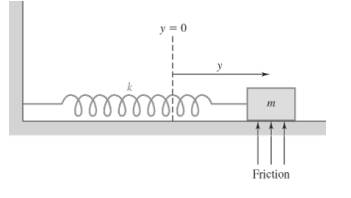
Sticky Friction. An alternative for the damping friction model

Figure
(The function sign(s) is
Thus, if the mass is at rest, friction balances the spring force if
a. Taking
b. Form the phase plane equation for (17) when
where the plus sign prevails for
c. Identify the trajectories in the phase plane as two families of concentric semicircles. What is the center of the semicircles in the upper half-plane? The lower half-plane?
d. What are the critical points for (17)?
e. Sketch the trajectory in the phase plane of the mass released from rest at
Want to see the full answer?
Check out a sample textbook solution
Chapter 5 Solutions
Pearson eText Fundamentals of Differential Equations with Boundary Value Problems -- Instant Access (Pearson+)
- Good Day, Kindly assist me with this query.arrow_forward12. Check to see if the following set of functions is orthogonal on the interval [0,3] with respect to the integral inner product. Show all work. Recall that a set of functions is orthogonal if all pairs of functions are orthogonal. πα {cos (777), sin (7), 1}arrow_forwardA 24-1 design has been used to investigate the effect of four factors on the resistivity of a silicon wafer. The data from this experiment are shown in Table 4. Table 4: Resistivity Experiment for Exercise 5 Run A B с D Resistivity 1 23 2 3 4 5 6 7 8 9 10 11 12 I+I+I+I+Oooo 0 0 ||++TI++o000 33.2 4.6 31.2 9.6 40.6 162.4 39.4 158.6 63.4 62.6 58.7 0 0 60.9 3 (a) Estimate the factor effects. Plot the effect estimates on a normal probability scale. (b) Identify a tentative model for this process. Fit the model and test for curvature. (c) Plot the residuals from the model in part (b) versus the predicted resistivity. Is there any indication on this plot of model inadequacy? (d) Construct a normal probability plot of the residuals. Is there any reason to doubt the validity of the normality assumption?arrow_forward
- 1. Check to see if the matrix below is (a) symmetric (b) skew-symmetric (c) orthogonal You need to check all three cases. 2. Compute the eigenvalues and verify that they satisfy the required properties for such matrix. (For example, if the matrix is symmetric, then the eigenvalues satisfy certain property. Likewise, if a matrix is skew-symmetric or if it is orthogonal.) 0.28 0.96 -0.96 0.28arrow_forward14. (a) Find all the eigenvalues and their algebraic and geometric multiplicities. (b) Find bases for the corresponding eigenspaces. (c) Is the matrix is diagonalizable? Explain. If it is, then find P and D. 5 2 -9 6arrow_forwardon donne f(x) da fonction derive dhe do fonction fcsos calcule f'(x) orans chacun des Cas sulants: 3 1) f(x)=5x-11, 2- f (x) = ->³ 3-1(x) = x² 12x +π; 4-f(x)=- 5-f(x) = 33-4x6-609)=-3x²+ 7= f(x) = x + 1.8-f(x) = 4 s-f(x) = x++ X+1 -x-1 2 I 3x-4 девоarrow_forward
- 13. Check to see if the following set of functions is orthogonal on the interval [-3, 3] with respect to the integral inner product. Show all work. Recall that a set of functions is orthogonal if all pairs of functions are orthogonal. Пх COS 3 {cos (), sin().1} 3arrow_forwardNeed help solving please!arrow_forwardThe numbers of hours worked on homework (per week) by 400 statistics students are shown below. Cumulative Relative Number of hours Frequency Relative Frequency Frequency 0arrow_forwardA semiconductor manufacturer produces devices used as central processing units in personal computers. The speed of the devices (in megahertz) is important because it determines the price that the manufacturer can charge or the devices. Consider the observations in Sample A were generated from a specific process, whereas the observations in Sample B were generated from a different process. According to the comparative boxplot as follows, which conclusion is INCORRECT? Boxplot of Device Speed in Sample A and B 800 780 Speed of Device (MHz) 760 740 720 700 680 660 640 620 600 Sample A Sample B The median values for both Sample A and Sample B are essentially the same. Sample B contains an outlier. In Sample B, the number of devices with speeds less than 660 MHz is approximately equal to the number of devices with speeds greater than 700 MHz. In Sample A, the number of devices with speeds greater than 680 MHz is approximately 1.5 times the number of devices with speeds less than 680 MHz.arrow_forwardThe histogram below displays the power consumption (in watts) of various industrial machines during a trial period, categorized into power consumption intervals. The rectangle for the interval 1000-1500 watts is missing. What should its height be? (Two decimal places.) Histogram of Power Consumption of Various Machines Relative Frequency 0.30 0.25 0.20 0.25 0.15 0.15 0.15 0.10 0.10 0.10 0.05 0.05 0.00 500 1000 1500 2000 2500 3000 3500 4000 Power Consumption (Watts)arrow_forward5. By referring to the discussion in Sec. 14 related to Fig. 19 there, find a domain in the z plane whose image under the transformation w = z² is the square domain in the w plane bounded by the lines u = 1, u = 2, v = 1, and v = = 2. (See Fig. 2, Appendix 2.)arrow_forwardarrow_back_iosSEE MORE QUESTIONSarrow_forward_ios
 Discrete Mathematics and Its Applications ( 8th I...MathISBN:9781259676512Author:Kenneth H RosenPublisher:McGraw-Hill Education
Discrete Mathematics and Its Applications ( 8th I...MathISBN:9781259676512Author:Kenneth H RosenPublisher:McGraw-Hill Education Mathematics for Elementary Teachers with Activiti...MathISBN:9780134392790Author:Beckmann, SybillaPublisher:PEARSON
Mathematics for Elementary Teachers with Activiti...MathISBN:9780134392790Author:Beckmann, SybillaPublisher:PEARSON
 Thinking Mathematically (7th Edition)MathISBN:9780134683713Author:Robert F. BlitzerPublisher:PEARSON
Thinking Mathematically (7th Edition)MathISBN:9780134683713Author:Robert F. BlitzerPublisher:PEARSON Discrete Mathematics With ApplicationsMathISBN:9781337694193Author:EPP, Susanna S.Publisher:Cengage Learning,
Discrete Mathematics With ApplicationsMathISBN:9781337694193Author:EPP, Susanna S.Publisher:Cengage Learning, Pathways To Math Literacy (looseleaf)MathISBN:9781259985607Author:David Sobecki Professor, Brian A. MercerPublisher:McGraw-Hill Education
Pathways To Math Literacy (looseleaf)MathISBN:9781259985607Author:David Sobecki Professor, Brian A. MercerPublisher:McGraw-Hill Education





